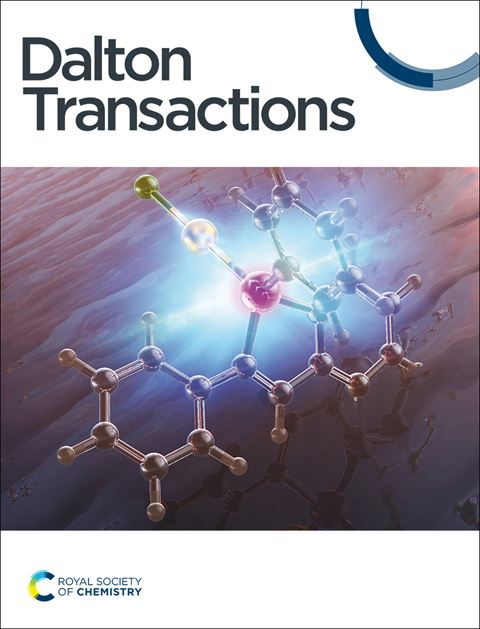A highly sensitive ratiometric optical thermometer based on Sr2MgWO6 double perovskite doped with Dy3+ exploiting thermally coupled and uncoupled levels
IF 3.5
3区 化学
Q2 CHEMISTRY, INORGANIC & NUCLEAR
引用次数: 0
Abstract
The increasing demand for highly sensitive optical thermometers operating within a wide temperature range necessitates the development of new phosphors. In this work, the potential of temperature sensing performance of a novel yellow-emitting phosphor, Sr2MgWO6 double perovskite, doped with varying concentrations of Dy3+ was investigated for the first time. Increasing the concentration of Dy3+ from 0% to 7% shifted the color of luminescence from blue to yellowish-orange within the CIE1931 color space. The energy transfer efficiency from (WO6)6- to Dy3+ also increased significantly to 98.4%. Moreover, the sample doped with 3% Dy3+ showed the highest emission intensity, with concentration beyond this threshold inducing concentration quenching. This phenomenon was primarily governed by dipole-dipole interactions. The highest quantum yield was found to be 30.7% for the sample doped with 3%Dy3+. Upon 266 nm excitation wavelength, the temperature sensing ability of the samples doped with 3%, 5%, and 7%Dy3+ was examined based on the fluorescent intensity ratio between thermally coupled and uncoupled levels. It showed that the relative thermal sensitivity of Sr can be tuned by changing the Dy3+ concentration. Sr-max = 3.24%K-1 was obtained for the sample doped with 3%Dy3+ at 193 K within the 80 - 273 K operating range for thermally uncoupled levels. For thermally coupled levels, the Sr-max value reached 1.35%K-1 at 333 K for the sample doped with 7%Dy3+ in the range of 293 – 593 K. These results demonstrated the enormous potential of the studied materials for thermal sensing application.基于掺杂 Dy3+ 的 Sr2MgWO6 双包晶石的高灵敏度比率光学温度计,利用了热耦合和非耦合水平
随着对可在宽温度范围内工作的高灵敏度光学温度计的需求日益增长,有必要开发新型荧光粉。在这项工作中,首次研究了掺杂不同浓度 Dy3+ 的新型黄色发光荧光粉 Sr2MgWO6 双包晶的温度传感性能潜力。将 Dy3+ 的浓度从 0% 提高到 7%,在 CIE1931 色彩空间内,发光颜色从蓝色变为橘黄色。从 (WO6)6- 到 Dy3+ 的能量传递效率也显著提高到 98.4%。此外,掺杂了 3% Dy3+ 的样品显示出最高的发射强度,浓度超过这一阈值会导致浓度淬灭。这种现象主要受偶极-偶极相互作用的影响。掺杂 3%Dy3+ 的样品的量子产率最高,达到 30.7%。在 266 nm 的激发波长下,根据热耦合和非耦合水平之间的荧光强度比,考察了掺杂 3%、5% 和 7%Dy3+ 的样品的温度感应能力。结果表明,可以通过改变 Dy3+ 的浓度来调整 Sr 的相对热灵敏度。掺杂了 3%Dy3+ 的样品在 193 K 的 80 - 273 K 工作范围内获得了 Sr-max = 3.24%K-1 的热非耦合水平。对于热耦合水平,掺杂了 7%Dy3+ 的样品在 333 K 时的 Sr-max 值达到了 1.35%K-1 (293-593K)。
本文章由计算机程序翻译,如有差异,请以英文原文为准。
求助全文
约1分钟内获得全文
求助全文
来源期刊

Dalton Transactions
化学-无机化学与核化学
CiteScore
6.60
自引率
7.50%
发文量
1832
审稿时长
1.5 months
期刊介绍:
Dalton Transactions is a journal for all areas of inorganic chemistry, which encompasses the organometallic, bioinorganic and materials chemistry of the elements, with applications including synthesis, catalysis, energy conversion/storage, electrical devices and medicine. Dalton Transactions welcomes high-quality, original submissions in all of these areas and more, where the advancement of knowledge in inorganic chemistry is significant.
 求助内容:
求助内容: 应助结果提醒方式:
应助结果提醒方式:


